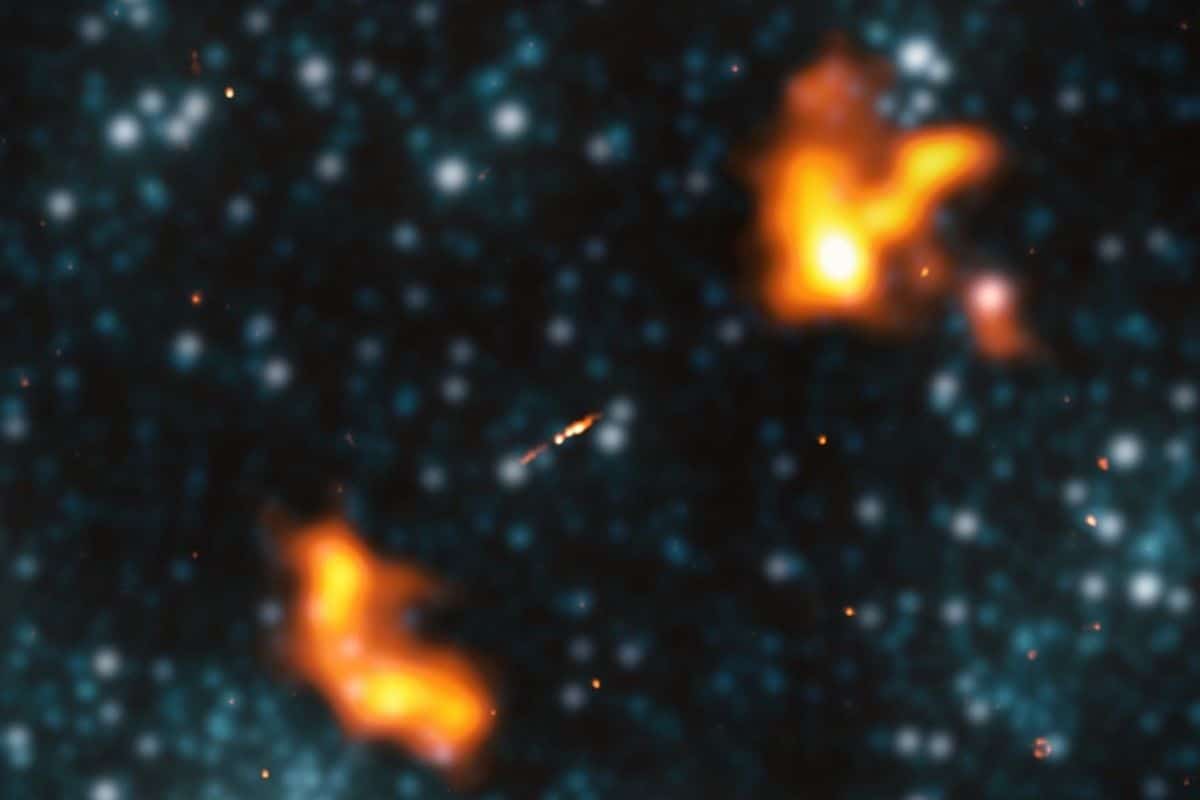
Not only is this the largest radio galaxy found to date, it also challenges common ideas about the growth of radio systems.
Leiden astronomers accidentally discovered a gigantic radio galaxy – a galaxy that radiates very strongly at radio wavelengths. The structure is at least 16 million light-years long, which makes it comparable to 100 galaxies in a row. And at this bizarre size, the galaxy goes down in the books as the largest radio galaxy ever discovered.
As you may know, there is a supermassive black hole at the heart of many galaxies. Such a black hole exerts great pressure on its surroundings. For example, it inhibits the birth of new stars. Sometimes that is quite brutal. The black hole then creates two jet streams (or plumes) that kick the material from which baby stars are born out of the galaxy at nearly the speed of light. The ‘star dust’ heats up so strongly that it disintegrates into plasma and emits radio light. And precisely this light has now been collected with the help of the pan-European LOFAR telescope, whose heart is in the Netherlands.
Named Alcyoneus – after a mythological giant who fought Heracles and other Olympians for supremacy over the cosmos – the “radio giant” in question is some three billion light-years away.
Distance
Despite that staggering distance, the giant appears almost the same size as our moon in the night sky. The researchers concluded from this that the structure must have a record length. The fact that astronomers are only now noticing the radio giant is because the plumes detected (see box) are relatively faint. Finally, they caught a glimpse of the giant by editing a collection of existing images to make subtle patterns more visible.

The huge radio galaxy Alcyoneus. Image: Martijn Oei et al.
The photo of the two plasma plumes is very special. For never before have researchers seen such a structure spawned by a single galaxy. The discovery shows that the spheres of influence of some galaxies extend far beyond their immediate surroundings.
cosmic web
Interestingly, Alcyoneus’ plumes may be revealing information about the still largely elusive filaments of the cosmic web: another name for the modern-day universe, resembling a network of threads and nodes that astronomers call filaments and clusters, respectively. Alcyoneus, like our Milky Way, inhabits a filament. As a result, its plumes get the wind from the front as they move through the medium. This means that the plumes slowly change course and shape. It has long been suspected that the shape and pressure in the plumes of radio galaxies might be related to filament properties, but never has a system been found where such a connection is so plausible as in Alcyoneus.
Mystery
All in all, the discovery of such a huge structure is a milestone. Why Alcyoneus is so record-breaking is still a mystery. Explanations such as a pre-eminently massive black hole, a large star population (and therefore a lot of stardust) or extremely powerful jet streams have already been debunked. Because surprisingly enough, Alcyoneus appears to score below average in all those areas.
The remarkable find therefore casts doubt on current ideas about the growth of radio systems. In the near future, the team will investigate whether the environment of radio systems can explain gigantic growth.
Source material:
†Leiden astronomers find largest radio galaxy ever” – University of Leiden
Image at the top of this article: Martijn Oei et al.